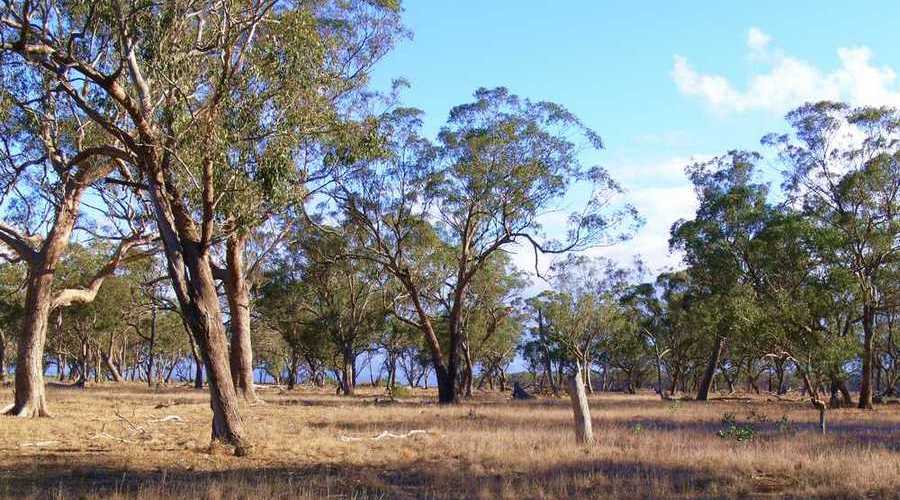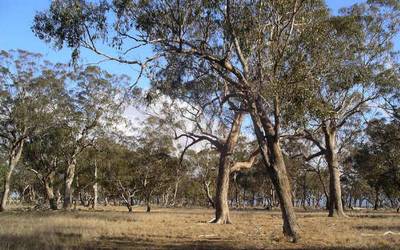
15/10/2006
Pinkerton Forest (50ha) and Bush’s Paddock (45 ha) are located in the Shire of Melton on the western slope of Mt. Cotterell. They form part of the Victorian Volcanic Plains bioregion and contains the ecological vegetation classes of plains grassland, plains grassy woodland, plains grassy wetland and plains sedgy wetland.
The average rainfall is 450mm focusing on Mt. Cotterell (height 204 metres).
These basalt plains grasslands are of State significance and are important as there remains just 0.01percent of native grasslands in Victoria today.
Pinkerton Landcare and Environment Group co-jointly manages the restoration of the grasslands in association with Western Water (Pinkerton Forest) and the Shire of Melton (Bush’s Paddock)
Restoration planting and propagation
Restoration planting has been undertaken using seeds from local provenance in the Mt. Cottrell/Exford region. Some of these have been propagated by members of the group. The species selection and composition for Pinkerton Forest has been modelled on the nearby Eynesbury woodland, of national significance, these being Sweet bursaria (Bursaria spinosa), Fragrant salt bush (Rhagodia parabolica), Golden wattle (Acacia pycnantha), and Gold dust wattle (Acacia acinacea). The planting of the regionally significant Turkey-bush (Eremophila deserti), propagated by a member of the group has been undertaken.
The result is that the grey box seedlings started growing, and gradually the understory, the previously unnoticed shrubs such as Turkey bush (Eremophilia deserti), Sweet bursaria (Bursaria spinosa) and Tree violet (Hymenanthera dentata) started to reappear. Lightwood and Gold-dust wattle (Acacias implexa and acinacea) have sprung up from nowhere, certainly not in the trial area which was burnt a few years ago, rare fungi have popped up, the native stipa grasses have set seed, and wild flowers such as Tufted blue bell (Wahlenbergia communis), White Lobe-seed daisies (Brachyscome dentata), New Holland daisy (Vittadinia cuneata), and Pussy tails (Ptilotus spathulatus) have flowered and set seed.
The grasslands are seen at their best in spring and summer when the wildflowers are flourishing and the native grasses are setting seed.
After six years of restoration work the wildlife has started to return to the woodland, using it as part of the Exford network of grassy grey box woodlands linked to the Werribee River.
Now, nine years further into the restoration process new species have emerged when favourable seasonal conditions have presented. The landcare group has also learnt more about inter-competition between native species, particularly when local indigenous species have been introduced to grassy woodlands, which may not have been present prior to .European settlement and the importance which geo-morphology features (aspect, drainage, slope and elevation) have on species dominance.
Emergent species: Bower spinach (Tetragonia implexicoma), Cut-leaf Goodenia (Goodenia pinnatifidi), Plains joyweed (Alternanthera sp.1), Small vanilla lily (Arthropodium minus), Sticky everlasting (Xerochrysum viscosum), Smooth Solenogyne (Solengyne dominii).
Indigenous Plants of Pinkerton Forest
Cut-leaf Goodenia (Goodenia pinnatifida)
https://www.pinkertonforest.com/images/stories/pinkertonforest/DSC_0452.JPG
Sticky Everlasting (Xerochrysum viscosum)
https://www.pinkertonforest.com/images/stories/pinkertonforest/DSC_0453.JPG
Basalt Daisies (Brachyschome basaltica)
https://www.pinkertonforest.com/images/stories/pinkertonforest/DSC_0489.JPG
Bower spinach (Tetragonia implexicoma)
https://www.pinkertonforest.com/images/stories/pinkertonforest/CSC_0460.JPG
Many existing plants have flourished, the grasses and wildflowers occupying previous degraded patches, the spreading wildflowers are Small-leaved Clematis, Variable Glycine and Common New Holland Daisy.
It was disappointing to see the introduced Fragrant Saltbush spreading into large clumps and smothering the native grasses, also to see Golden Wattle seedlings appearing in their hundreds. Both environmental invaders are being incrementally removed. One possible explanation is that as Eynesbury Woodland is located on a relatively flat site with two drainage lines traversing it; this situation doesn’t appear to be favourable to native grass, but is favourable to Fragrant Saltbush and Golden Wattle. On the other hand Pinkerton Forest is located on the western flank of Mt. Cottrell, has a higher elevation and is drier than Eynesbury, and the slope drains towards the Werribee River, these combined factors appear to favour the native grasses and flowers in Pinkerton Forest.
Frances Overmars 15 March 2015
Photos of Pinkerton Forest
Photos of Pinkerton Forest
Photos of Pinkerton Forest
Photos of Pinkerton Forest
Photos of Pinkerton Forest
Photos of Pinkerton Forest
Photos of Pinkerton Forest
Photos taken by Mischa Rowan in 2006









